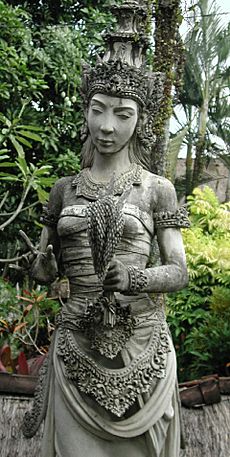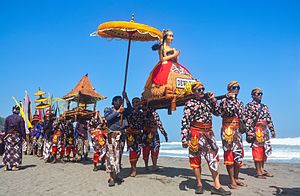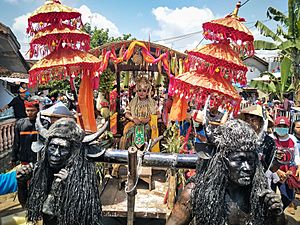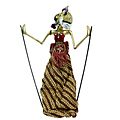Dewi Sri facts for kids
| Grouping | Goddess |
|---|---|
| Sub grouping | Immortality |
| Country | Indonesia |
| Region | Java, Bali, Lombok |
Dewi Sri (also known as Shridevi) is a special goddess from Indonesia. People in Java, Bali, and Lombok islands still worship her. She is known as the Goddess of rice and fertility. This means she helps rice grow well and brings new life and good harvests.
The idea of a rice goddess started a very long time ago. It began when people first learned how to grow rice in Asia. This belief might have come with people who moved to Indonesia long ago. Many different groups in Indonesia have similar stories about rice spirits. Dewi Sri's story is very old, going back to the first century. She is often seen as a form of the Hindu goddess Lakshmi, who is linked to wealth and good fortune.
Contents
The Story of Dewi Sri
Dewi Sri is believed to be in charge of rice, which is a main food for Indonesians. Because of this, she is also linked to life, wealth, and good times. She helps kingdoms like Sunda, Majapahit, and Mataram have plenty of rice. She also helps prevent bad things like hunger and sickness. She is often connected to the rice paddy snake.
How Rice Came to Be
Most stories about Dewi Sri tell how the rice plant first appeared. One famous story is called "Wawacan Sulanjana."
A long time ago in heaven, Batara Guru, the highest god, asked all the gods and goddesses to help build a new palace. He said anyone who didn't help would lose their arms and legs. One god, Antaboga (Ananta Boga), a Nāga god shaped like a snake, was very worried. He had no arms or legs and didn't know how to help.
Anta asked Batara Narada, Batara Guru's younger brother, for advice. Narada was also unsure. Anta became very sad and cried. As he cried, three teardrops fell to the ground. These tears turned into three beautiful, shiny eggs, like jewels or pearls. Batara Narada told Anta to give these eggs to Batara Guru. He hoped this gift would make Batara Guru happy and understanding of Anta's problem.
Anta carried the three eggs in his mouth and went to Batara Guru's palace. On his way, an eagle asked him a question. Anta couldn't answer because he was holding the eggs. The eagle thought Anta was being rude and attacked him. One egg fell and broke. Anta quickly hid, but the eagle attacked again. This left Anta with only one egg to give to Batara Guru. The two broken eggs turned into two wild boars named Kalabuat and Budug Basu.
Finally, Anta reached the palace and gave his last shiny egg to Batara Guru. Batara Guru happily accepted it and asked Anta to keep the egg warm until it hatched. The egg hatched into a very beautiful baby girl. Anta gave the baby girl to Batara Guru and his wife.
The baby girl was named Nyai Pohaci Sanghyang Asri. She grew up to be a stunning princess. All the gods were drawn to her, even her foster father, Batara Guru. The other gods worried that Batara Guru's feelings for his foster daughter would cause problems in heaven. So, they decided she had to die to keep peace in heaven and protect her purity.
She was made to die, and her body was buried in a secret place on Earth. But because Sri Pohaci was so pure and divine, something amazing happened at her grave. Many useful plants grew from her body. From her head grew coconuts. From her nose, lips, and ears grew different spices and vegetables. Her hair became grass and flowering plants. Her arms and hands grew into teak and other wood trees. From her thighs grew different types of bamboo. Her legs grew into various tuber plants. And from her belly button grew the most important plant of all: padi (rice). Some stories say white rice grew from her right eye and red rice from her left eye.
People believe that all these important plants, which humans need to live well, came from Dewi Sri's body. From that time on, the people of Java honored her as the kind "Goddess of Rice" and fertility. In the old Sunda Kingdom, she was seen as the most important goddess for farming communities.
Many myths about Dewi Sri also include her brother, Sedana. In these stories, Dewi Sri and Sedana are always separated, either by death or by choosing different paths. Sometimes, Sri is linked to the large Rice Paddy Snake, and Sedana is linked to the paddy swallow. The snake is a special symbol of new life and growth in Asia.
What Does She Look Like?
Dewi Sri is always shown as a young, beautiful woman. She is slim but also curvy, with special facial features that match the local art style. She looks like a woman at the peak of her youth and ability to bring new life. In Javanese art, Dewi Sri usually wears green, white, or golden yellow clothes. She has royal jewelry, similar to the Hindu goddess Lakshmi. She often holds a rice plant full of grains in one hand, which is her special symbol.
In Javanese culture, especially in wayang puppet shows, she has a white face, thin, downward-looking eyes, and a calm expression. Many of her qualities are similar to the wayang character Sinta from the Javanese story of the Ramayana.
The loro blonyo statues, which show a male and female figure, are also linked to Dewi Sri and Sedana. They represent happiness and harmony in the home. People in Bali make special figures of Dewi Sri from young coconut leaves (janur), lontar leaves, or rice flour cakes.
Honoring Dewi Sri
Dewi Sri is still highly respected by the Javanese, Balinese, and Sundanese people of Indonesia. Even though most Indonesians are Muslims or Balinese Hindus, their ancient beliefs remain strong. These beliefs are often practiced alongside Islam, Buddhism, Hinduism, and Christianity without problems. Royal palaces in places like Cirebon, Ubud, Surakarta, and Yogyakarta also keep these traditions alive. The Javanese harvest ceremony is called Sekaten, which also happens during the celebration of Prophet Muhammad's birthday.
Traditional Javanese people, especially those who follow Kejawen beliefs, often have a small shrine called Pasrean (the place of Sri) in their homes. This shrine is decorated with a statue or picture of Dewi Sri, sometimes with Sedana. It might also have a small knife used for harvesting rice. This shrine is often decorated with carvings of snakes. People offer food and prayers to Dewi Sri. They ask her to bring health and good fortune to their family. The Loro Blonyo statues are seen as Dewi Sri and Sedana, symbolizing a happy family.
Among rural Javanese people, if a snake enters a house, they don't chase it away. Instead, they give it offerings. They believe the snake is a good sign for a successful harvest. Also, a special ceremonial keris (a traditional dagger) might be used by traditional healers. They perform a special ceremony to bless and protect the villagers, their homes, and the rice seeds.
The Javanese and Sundanese people have a traditional ceremony called mapag Sri before the rice harvest. Mapag Sri means "to pick up Sri" or "to invite Sri." This ceremony calls the spirit of Sri to their village. It is also a way to say thank you for a good harvest to come.
The Sundanese people, especially those who follow Sunda Wiwitan beliefs, have their own special festival for her. It's called the Seren Taun annual rice harvest festival. This tradition goes back to the old Kingdom of Sunda. During ceremonies to bless rice seeds or during harvest, Sundanese and Baduy people sing special songs. These songs are meant to invite the goddess to come to Earth. They ask her to bless the rice seeds and the farmers. They also ask her to ward off bad luck and prevent misfortune.
The Balinese people build special shrines for Dewi Sri in their rice fields. They often make figures of the rice goddess from carefully woven young coconut leaves (janur), lontar leaves, or colored sticky rice. These figures are called "Cili." In today's Balinese Hindu beliefs, Dewi Sri is seen as a mix of the Hindu goddesses Lakshmi, Devi, and Shri. She is also linked to rice, fertility, good harvests, and family happiness.
Similar rice goddesses can be found in other Asian countries. For example, Mae Po Sop is the Siamese rice goddess in Thailand. The Khmer people in Cambodia have Po Ino Nogar, their rice goddess.
Gallery
-
Dewi Sri in wayang puppet theatre
-
Cili, a Balinese Dewi Sri effigy from lontar palm leaf
-
Dewi Sri depicted in 1952 10 Rupiah banknotes
See also
 In Spanish: Dewi Shri para niños
In Spanish: Dewi Shri para niños








